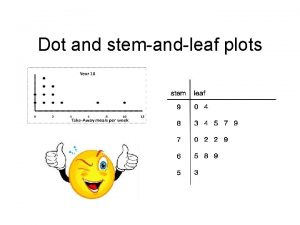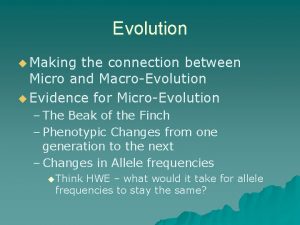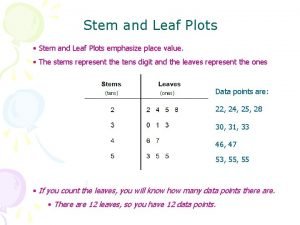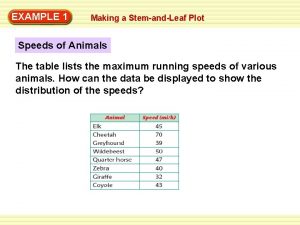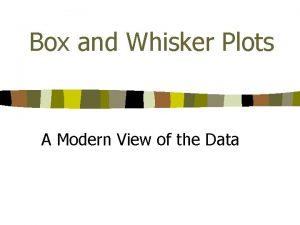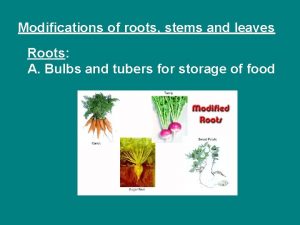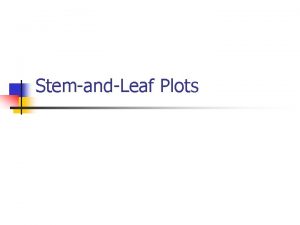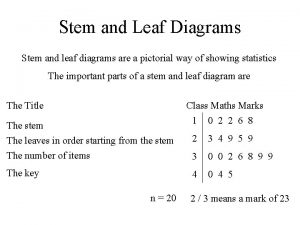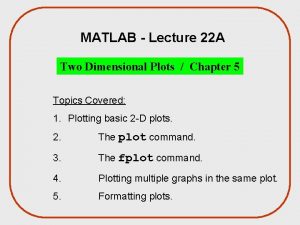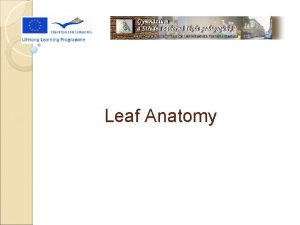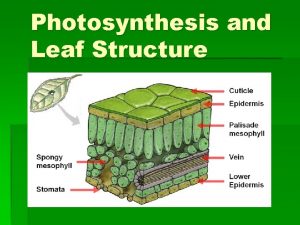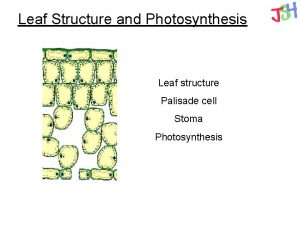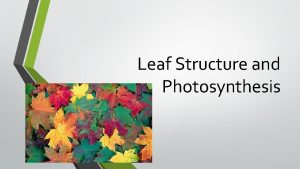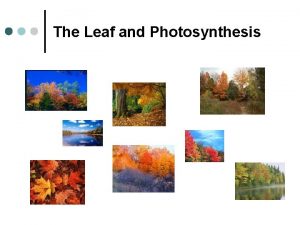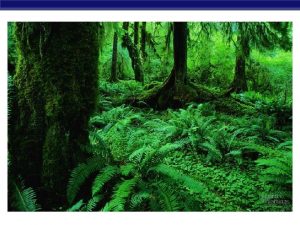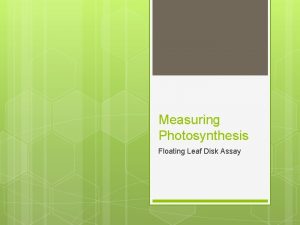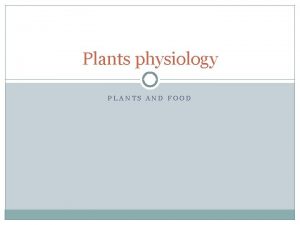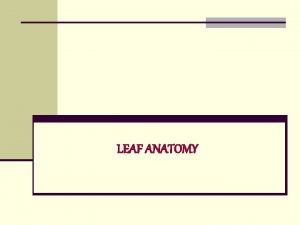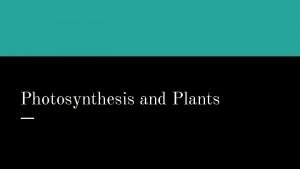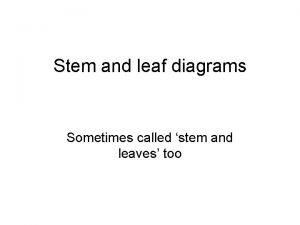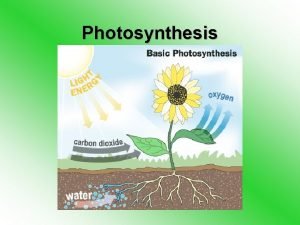PHOTOSYNTHESIS PLANTS STEM AND LEAF ANATOMY PHOTOSYNTHESIS REQUIRES






























- Slides: 30

PHOTOSYNTHESIS & PLANTS STEM AND LEAF ANATOMY

PHOTOSYNTHESIS REQUIRES: • Carbon dioxide from the atmosphere • Plants must have air flow in the leaves to allow carbon dioxide into the leaf and oxygen to leave • Water from the soil • Roots absorb water, channel it into vascular tissue (veins), and send it through stems to the leaves • Sunlight • Comes from above, so plants must position their chloroplasts to best compete for sunlight

CONFLICTING NEEDS PT. 1 • More sunlight is good with regards to energy absorption, but causes more evaporation of water • Water must be in the liquid form for it to be used for photosynthesis • Water vapor can be easily lost from leaves (“transpiration”)

BROADLEAF VS NEEDLE

BROADLEAF VS GRASS

LEAVES, EXTERNAL ANATOMY Observe a variety of sample leaves For each, consider its relative balance between light absorption and water conservation

LAB ACTIVITY – STEM OBSERVATION • Observe prepared slides of Zea stems and Tilia stems • Zea is corn. It is an annual plant (lives one growing season) with a herbaceous stem • Herbaceous stems are photosynthetic • Tilia is a woody perennial. It lives for several growing seasons. • Tilia stems are not photosynthetic • Note the growth rings • Compare and contrast the organization of vascular tissue • In the vascular bundles, identify the Xylem and Phloem cells • Xylem is used to transport water from roots to the stems and leaves • Phloem is used to transport dissolved sugars from the leaves to the stems and roots

LAB ACTIVITY – LEAF OBSERVATION • Observe prepared slides of Monocot and Dicot Leaf cross sections • For each type, note the concentration of photosynthetic cells • Consider what the anatomy of the leaf does with regard to • Absorbing sunlight • Allowing air flow • Providing a supply of water and preventing water loss by transpiration • Observe the arrangement of • • Vascular bundles Stomata Palisade mesophyll Spongy mesophyll

LEAF ANATOMY OBSERVATIONS Compare and Contrast with regard to : • Concentration of photosynthetic cells • Arrangement of vascular bundles • Location of stomata • Location and relative amount of air space

STOMATA Stomata are openings in the epidermis of the leaf to allow air to enter and leave Stomata are controlled by a pair of guard cells that can open or close the stomate as needed

GUARD CELLS AND STOMATA • The guard cells have thick, rigid cell walls on the surfaces facing the stomate • When the guard cells swell up with water, the outer surfaces stretch, causing the cells to curve • The curved shape creates an opening that allows air flow

CONFLICTING NEEDS PT. 2 • More sunlight is good with regards to energy Air flow is necessary for gas exchange, but. . . • Space devoted to air flow is space that is not available for chloroplasts • More air flow allows more carbon dioxide into the leaf, and facilitates movement of oxygen out, but also allows water vapor to escape

PHOTORESPIRATION • Remember that the first step in the Calvin Cycle, the carboxylation of Ru. BP, is subject to competitive inhibition by O 2. • The enzyme Rubisco can fix either CO 2 or O 2 to Ru. BP. • If photosynthesis were to progress with no air flow, eventually the concentration of CO 2 would become so low, and O 2 so high, that O 2 would be fixed to Ru. BP at a high rate, bringing the Calvin Cycle to a grinding halt • Efficient photosynthesis depends upon maintaining a high concentration of CO 2 in the leaf

RESOLVING CONFLICTS ECOLOGICALLY • Plants that are good at conserving water are capable of thriving in dry climates, where they will not have any competition from plants that are not very good at conserving water • Plants that are good at maintaining air flow will thrive in climates that are moist. They will outcompete other plants that can’t maintain a constant supply of carbon dioxide. Unfortunately, they will dry out and die if they don’t also have a constant supply of water

THE C 3 STRATEGY • C 3, as in 3 carbons. C 3 refers to the 3 carbon compound PGA, which is the first stable step of the Calvin Cycle • C 3 photosynthesis is the standard photosynthetic system as described in the textbook • C 3 plants are generally very efficient at photosynthesis and exhibit a high level of productivity, but are more sensitive to water loss than C 4 or CAM plants

C 3 LEAF ANATOMY

C 3 LEAF ANATOMY – LABELLED DIAGRAM

PALISADE MESOPHYLL • C 3 leaves have a densely packed “palisade” layer at the top of the leaf to maximize light absorption and protect against water loss from the top of the leaf

UPPER EPIDERMIS AND CUTICLE • The upper epidermis has very few stomata, forming a sealed upper surface • The upper epidermis also secretes a waxy cuticle, forming a water-tight barrier

SPONGY MESOPHYLL • The lower half of the leaf consists largely of loosely aggregated cells with plenty of air space, associated with plentiful stomata in the lower epidermis, to allow the exchange of CO 2 and O 2

THE TRADE OFF The flow of air in the leaf minimizes photorespiration, but allows transpiration (water evaporation and loss )

THE C 4 STRATEGY • C 4 plants are better adapted to conserve water • The leaves are more compact, with less exposed surface, which helps to retain water. • The mesophyll is more tightly packed, with less overall air space, which minimizes evaporation of water • The tightly packed mesophyll forms a “bundle sheath” surrounding vascular bundles which provides a ready supply of water to photosynthetic cells

C 4 LEAF ANATOMY

THE TRADE OFF • Less air flow means less water loss (transpiration), but also limits the ability of the leaf to exchange CO 2 and O 2, so the plant must provide CO 2 from an alternative pathway

THE C 4 PATHWAY (AKA – THE MALATE SHUTTLE) • C 4 plants use an active transport system to concentrate CO 2 into the cells of the bundle sheath • Mesophyll cells bind CO 2 to phosphenol pyruvate, resulting in a high concentration of Malate, that diffuses into the bundle sheath

THE C 4 PATHWAY (AKA – THE MALATE SHUTTLE) • Once malate enters the bundle sheath, it is decarboxylated, freeing CO 2 which can then enter the calvin cycle • Regenerating PEP requires energy from ATP • Since 6 molecules of CO 2 are required to make glucose, C 4 plants require 6 more ATP’s to make a sugar than C 3 plants do

C 3 VS C 4 COMPARE/CONTRAST • Each plant has variations in the density of cellular arrangement vs. air space that provides adaptive value for light absorption, air flow, and water conservation Different types of plants will compete with each other for air, water, sunlight, soil and space. • C 3 plants are better at competing for sunlight, but need more water. • C 4 plants are better at conserving water, but require more sunlight energy

THE CAM STRATEGY • CAM plants are succulents, with minimal exposed surface, a thick waxy cuticle, and maximum volume for storage of water.

THE CAM STRATEGY • CAM stands for Crassulacean Acid Metabolism • CAM plants close stomata during the day, and open them at night, allowing for air flow with a minimum of water loss • CO 2 entering the plant is immediately converted into larger molecules of water soluble organic acids • During the day, when sunlight is present, these acids can be decarboxylated to provide the CO 2 needed for the Calvin Cycle • This allows the plant to maintain high CO 2 levels, conserve water, and absorb sunlight all at the same time

CAM PHOTOSYNTHESIS
 Stem and leaf plot median
Stem and leaf plot median Double sided stem and leaf plot
Double sided stem and leaf plot Maple leaf and oak leaf homologous
Maple leaf and oak leaf homologous Leaf and non leaf procedure
Leaf and non leaf procedure Explain he plants in sap and leaf and wood
Explain he plants in sap and leaf and wood Dr frost stem and leaf
Dr frost stem and leaf Types of data displays
Types of data displays Whats a stem and leaf plot
Whats a stem and leaf plot Leaf and stem plot
Leaf and stem plot Stem and leaf spss
Stem and leaf spss A graphical display of data using bars of different heights
A graphical display of data using bars of different heights Favorite pizza toppings pie chart
Favorite pizza toppings pie chart Unordered stem and leaf plot
Unordered stem and leaf plot Diagramme stem and leaf
Diagramme stem and leaf Box and whisker plot calculator
Box and whisker plot calculator Disadvantage of box and whisker plot
Disadvantage of box and whisker plot Contoh stem and leaf
Contoh stem and leaf Root stem and leaf are modified in
Root stem and leaf are modified in Stem and leaf plot questions
Stem and leaf plot questions Stem and leaf exam questions
Stem and leaf exam questions Dr frost box plots
Dr frost box plots Dr frost
Dr frost Whats a stem and leaf plot
Whats a stem and leaf plot A stem and leaf plot is basically
A stem and leaf plot is basically Stem and leaf display
Stem and leaf display Interquartile range dot plot
Interquartile range dot plot Matlab 22a
Matlab 22a Stretched stem and leaf display
Stretched stem and leaf display Categorical frequency distribution example
Categorical frequency distribution example Dr frost stem and leaf
Dr frost stem and leaf What data are represented by the stem-and-leaf plot below?
What data are represented by the stem-and-leaf plot below?
